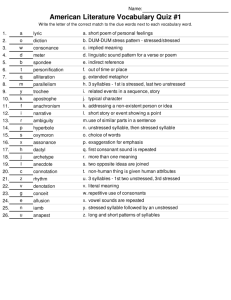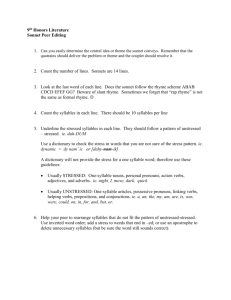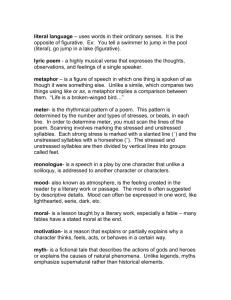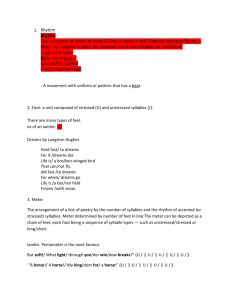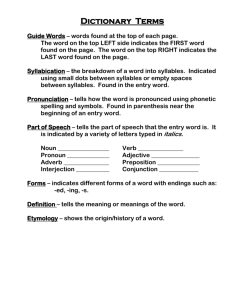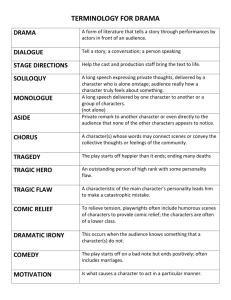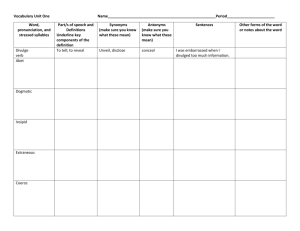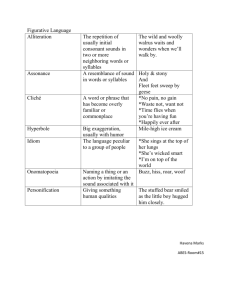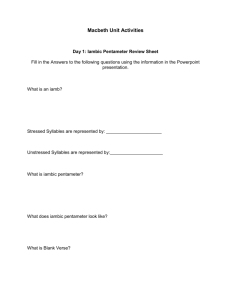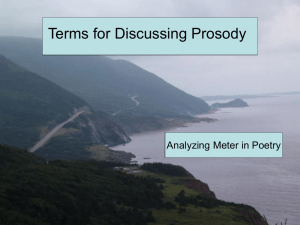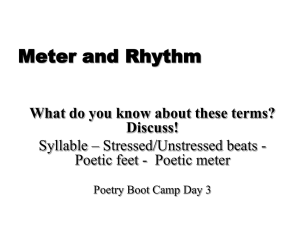Dactylic
advertisement
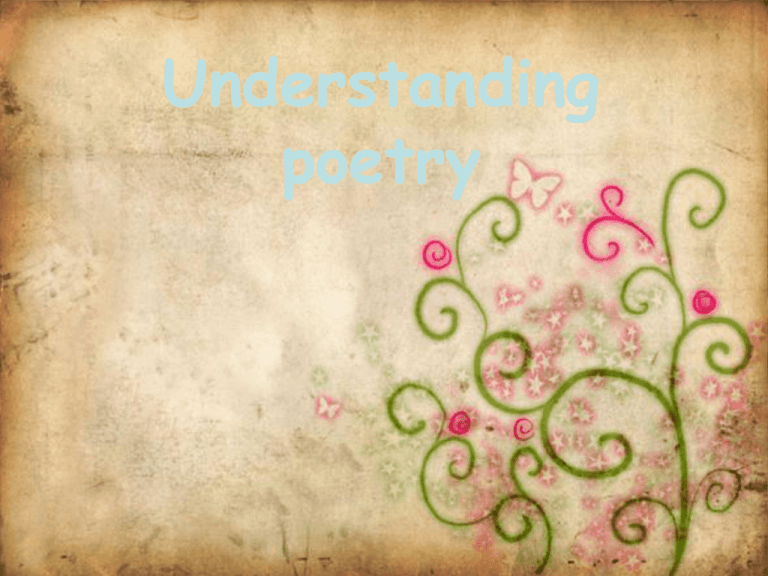
Understanding poetry I. Four basic types of verse • Accentual 重读诗 The accents determine the length of the line of poetry. • It can be found mainly in the works of the earlier poets, from the 8th century. • • Syllabic 音节诗 The French developed a way of counting the number of syllables to establish the length of the lines of verse. • • Accentual-syllabic 重读/音节诗 It came into being when the counting of accents and the counting of syllables in a line occurred ate the same time. It often rhymes; has meter and usually moves with a predictable regularity. • • • Free verse 自由诗 It has no fixed metrical pattern: it is free from counting, measuring, and meter. II. Stanza Types of stanzas: Couplets Quatrains Sextets Octets 2 -line stanzas 4 -line stanzas 6 -line stanzas 8 -line stanzas III. Foot and meter U = unstressed / = stressed Find the pattern U / = iambic / U = trochaic U U / = anapestic / U U = dactylic / / U = spondaic Example 1 • Shall I comPARE thee TO a SUMmer’s DAY? • Each pair of unstressed and stressed syllables makes up a unit called a foot. The line contains five feet in all, as shown next: • 1 2 3 4 5 • Shall I.|..comPARE.|..thee TO.|..a SUM.|..mer’s DAY? You need to know that each pattern is a foot! types of meter and the line length ..Monometer One Foot ..Dimeter Two Feet ..Trimeter Three Feet ..Tetrameter Four Feet ..Pentameter Five Feet ..Hexameter Six Feet ..Heptameter Seven Feet ..Octameter Eight Feet Five types of feet Iamb (Iambic) Unstressed + Stressed 2 Syllables Trochee(Trochaic) Stressed + Unstressed 2 Syllables Spondee(Spondaic) Stressed + Stressed 2 Syllables Anapest(Anapestic) Unstressed+Unstressed+Stressed 3 Syllables Dactyl (Dactylic) 3 Syllables Stressed+Unstressed+Unstressed Example 2 • • IAMBIC (U /) : That time of year thou mayst in me behold • • TROCHAIC (/ u): Tell me not in mournful numbers • • SPONDAIC (/ /): Break, break, break/ On thy cold gray stones, O Sea! • • • • • Meters with three-syllable feet are ANAPESTIC (u u /): And the sound of a voice that is still DACTYLIC (/ u u): This is the forest primeval, the murmuring pines and the hemlock (a trochee replaces the final dactyl) Example 3 • iambic pentameter (5 iambs, 10 syllables) • That time | of year | thou mayst | in me | behold • trochaic tetrameter (4 trochees, 8 syllables) • Tell me | not in | mournful | numbers • anapestic trimeter (3 anapests, 9 syllables) • And the sound | of a voice | that is still • dactylic hexameter (6 dactyls, 17 syllables; a trochee replaces the last dactyl) • This is the | forest pri | meval, the | murmuring | pine and the | hemlocks IV. Rhyme Rhyme is the repetition of the same or similar sounds often occurring at set intervals in a poem. Kinds of rhyme Alliteration About the lilting house and happy as the grass was green Assonance seat, weak Consonance luck, lick Half-rhyme (approximate rhyme) soul: oil; firth: forth; trolley: bully V. Figurative Language • • • • • • • • • • • • • • • • Contrast Irony Hyperbole or overstatement Understatement Metonymy Metaphor Simile Synecdoche Symbolism Onomatopoeia 拟声 Oxymoron 矛盾修饰法 Synesthesia 通感 Transferred epithet 转类形容词 Allegory 寓言 Apostrophe 顿呼 Conceit (outrageous metaphor) 奇喻 Conceit: a metaphor that goes beyond the original vehicle to other tenors and vehicles.采用迥异寻常的喻旨(tenor) 和喻体(vehicle)。 • A Valediction: Forbidding Mourning (John Donne) • • • • • • • • If they be two, they are two so As stiff with compasses are two; Thy soul, the fixed foot, makes no show To move, but doth, if th’ other do. And though it in the center sit, Yet when the other far doth roam, It leans and hearkens after it, And grows erect, as that comes home. Oxymoron: Living death; mute cry; “no light, but darkness visible” Synesthesia (通感): It takes one of the five senses and creates a picture or image of sensation as perceived by another. “the golden cry of the trumpet”; a fly’s “blue, uncertain stumbling buzz” Symbolism: Ocean—eternity • Similes and metaphors are used to make us take a closer look at a subject or to look at a subject in a new light. • Symbols and allegory, in contrast, force us to look beyond the literal meaning of the poem’s statement or action.
